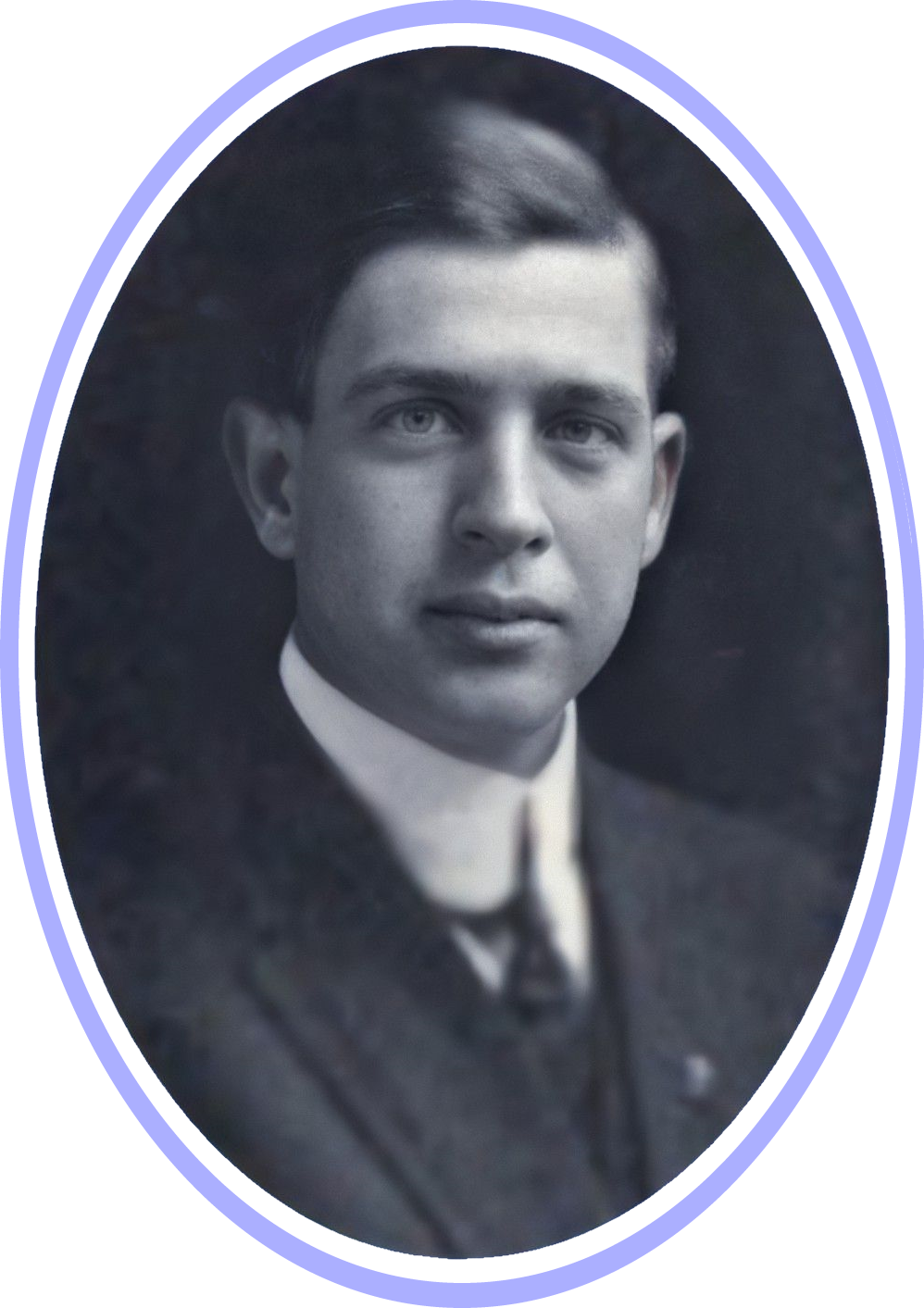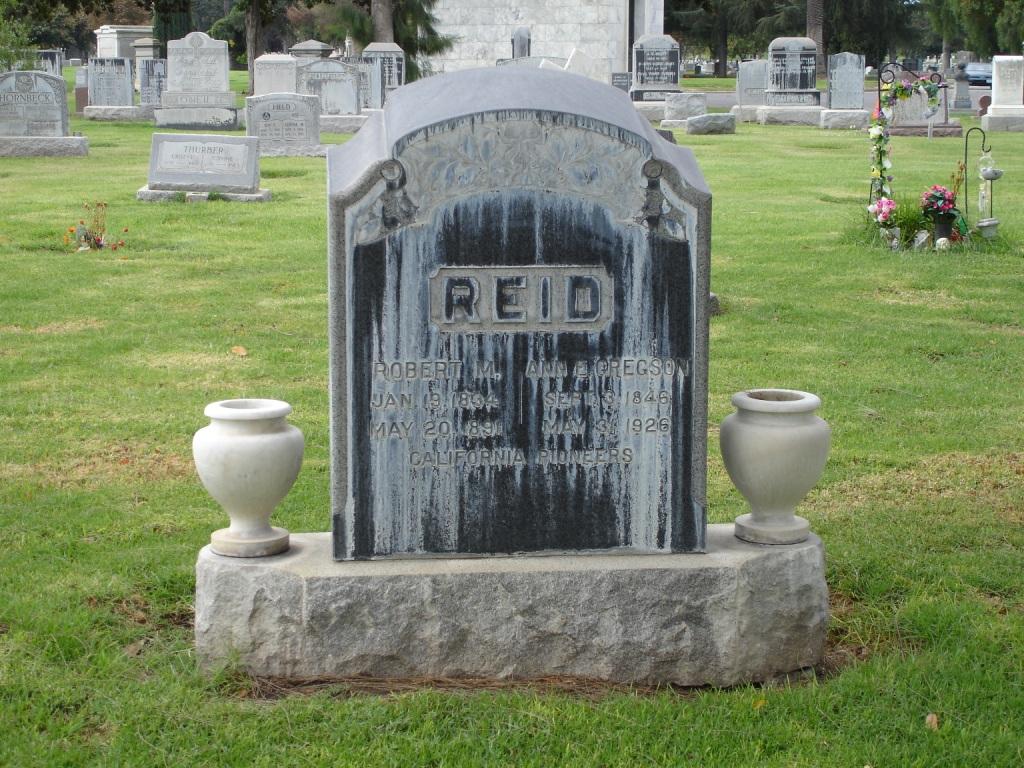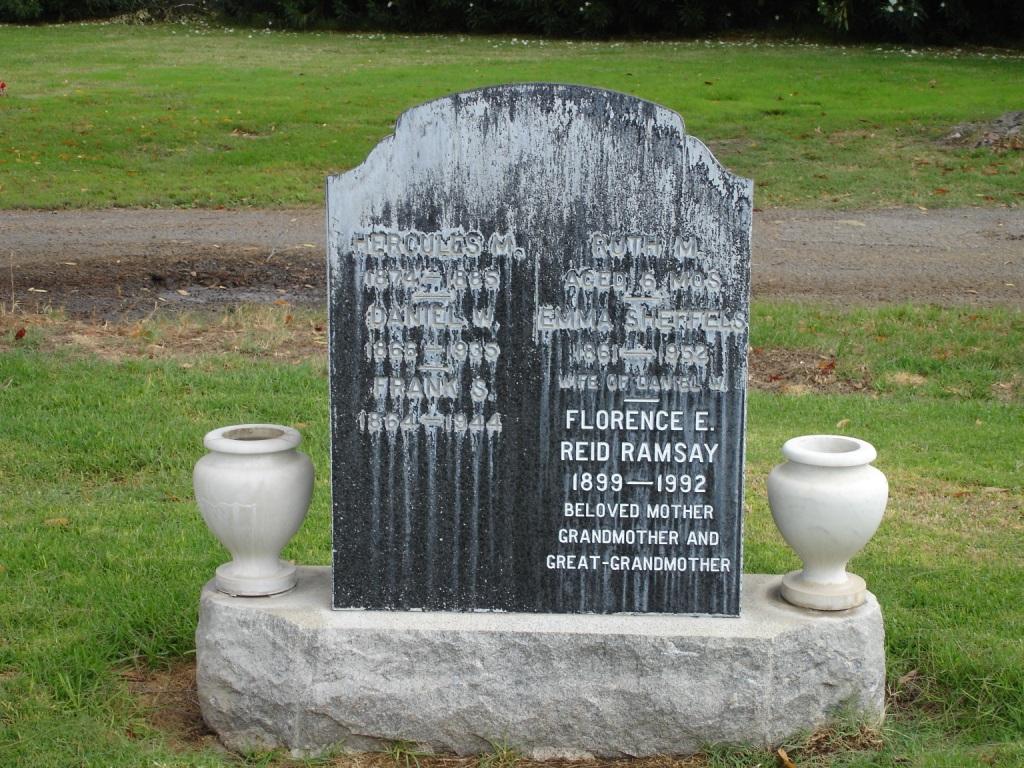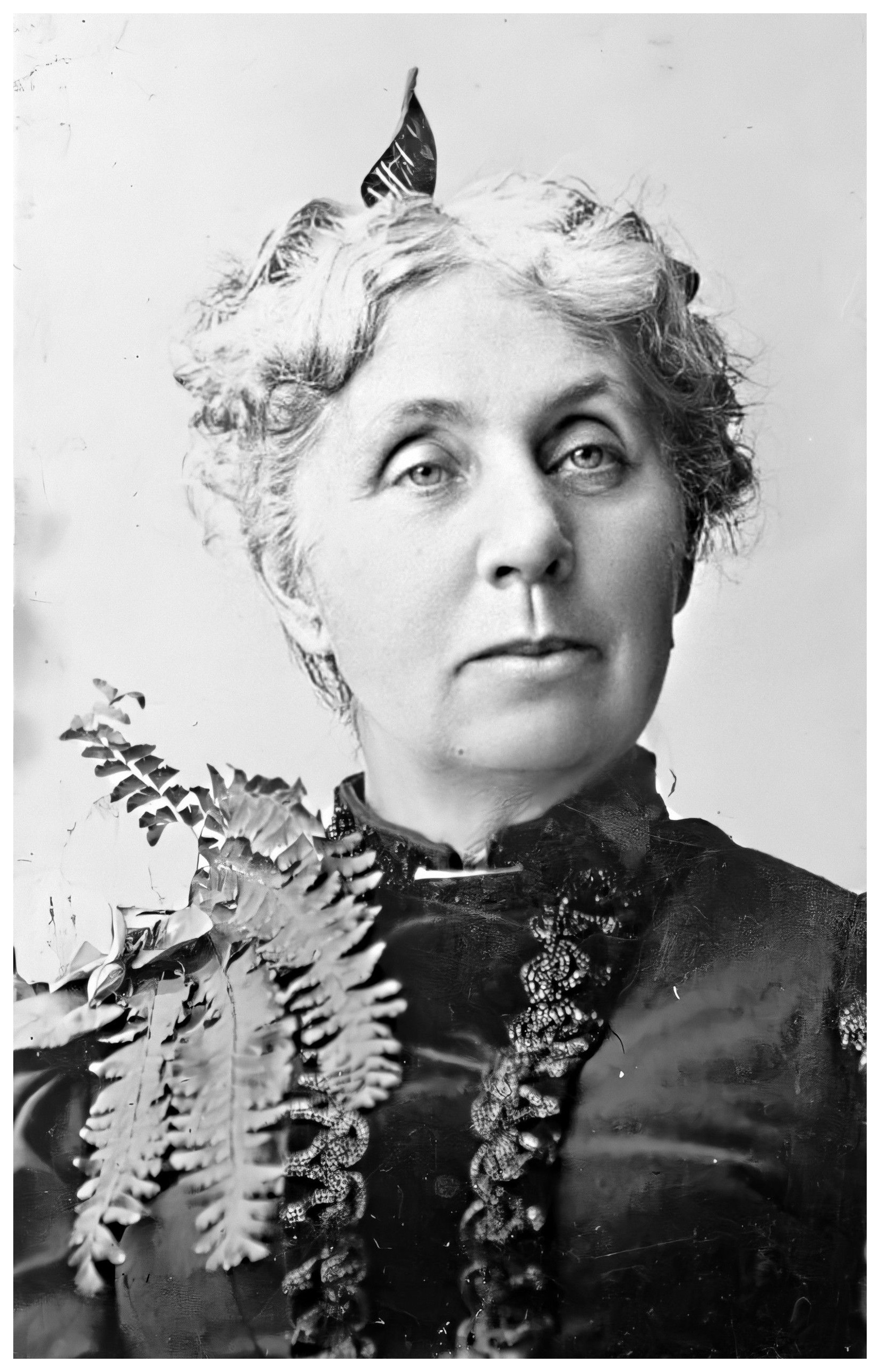
Ann Elizabeth Gregson and Robert Morisson Reid
ROBERT MORISSON REID, son of LETITIA SCOTT and DANIEL REID, was born January 19, 1834 in Indiana,1220 and died May 22, 1891 in Watsonville, Santa Cruz, California.1220 He is buried in Oak Hill Memorial Park, San Jose, Santa Clara, California.1220
He married ANN ELIZABETH GREGSON on November 8, 1862 in Sonoma County, California.1334 She was born September 3, 1846 in Fort Sutter, California,1165, 1225 and died May 31, 1926 in San Francisco, California.1165, 1225 She is buried in Oak Hill Memorial Park, San Jose, Santa Clara, California.1165
Children of ANN ELIZABETH GREGSON and ROBERT MORISSON REID:
- FRANK SUTTER REID, b. December 31, 1864, California;250, 1165 d. November 17, 1944, Agnew State Hospital, Santa Clara County, California.250, 1165
- DANIEL WEBSTER REID, b. January 19, 1866, California;1165 m. EMMA SHEFFELS in 18961165; d. November 23, 1935, Spokane, Washington.1165
- MARY ANN REID, b. November 2, 1867, California;456 m. CYRUS WESLEY RICHARDS in 1890; d. July 17, 1898.456
- IDA ELIZA REID, b. November 18, 1869, San Luis Obispo County, California;250, 1205 m. JAMES HARVEY ROWE on June 24, 1900 in San Jose, Santa Clara, California1164; d. December 7, 1952, Watsonville, Santa Cruz, California.250, 1205
- ALICE CURRY REID, b. April, 1871, California;56 m. ARTHUR ODELL COX on July 3, 1904 in San Jose, Santa Clara, California1164; d. 1962.
- WILLIAM SCOTT REID, b. January 8, 1873, San Miguel, California;250, 1165 m. (1) ELIZABETH JANE MAY on June 20, 1900 in San Andreas, Calaveras, California7540, m. (2) MAGNHILD KRINGLEN on November 21, 1916 in Oakland, Alameda, California10870; d. January 27, 1953, San Jose, Santa Clara, California.250, 1165, 1336
- HERCULES REID, b. 1874, California; d. 1885; bur. Oak Hill Memorial Park, San Jose, Santa Clara, California.1220
- JOHN GREGSON REID, b. July 31, 1877, Monterey County, California;250, 1165 m. (1) EDITH DREW on November 23, 1905 in San Jose, Santa Clara, California1156, m. (2) HELEN LUCILE GREENWALT in 1928; d. April 17, 1952, Palo Alto, Santa Clara, California.250, 1165
- LETITIA SCOTT REID, b. January 26, 1879, Monterey County, California;250, 13 m. (1) FRANCIS HENRY KEAN on May 7, 1904 in San Jose, Santa Clara, California1164, m. (2) ? OAKES between 1921 and 1932; d. March 23, 1973, San Mateo County, California.250
- BERTHA PATTERSON REID, b. February 10, 1881, Indian Valley, Monterey, California;250, 1213 m. EDWIN ELBERT SEELY on July 10, 1910 in Trinity Church, San Jose, Santa Clara, California1254; d. September 6, 1974, Los Gatos, Santa Clara, California.250, 1213
- ROBERT MORRISON REID, b. June 26, 1882, Monterey County, California; m. EDNA CLARE RINN on January 1, 1918 in Ida Grove, Ida, Iowa1231; d. March 15, 1971.56
- LEA JANE REID, b. March 3, 1883, Indian Valley, Monterey, California;250, 1211 d. October 20, 1973, Redwood City, San Mateo, California.250, 1211
- RUTH REID, b. 1887; d. before 1900.
- OLIVE FRANCES REID, b. October 9, 1887, Watsonville, Santa Cruz, California;250, 1210 m. ROBERT E. LIPTON; d. March 21, 1971, Watsonville, Santa Cruz, California.250, 1210

Robert


Newspaper Articles
Daily Evening Bulletin, March 28, 18781232
Robert M. Reid, a farmer of Indian Valley, Monterey county, has filed a petition in bankruptcy. His liabilities amount to $5,637 and assets, not claimed as exempt, to $4,860.

Santa Cruz Sentinel, May 31, 18914393
Mrs. R. M. Reid, who, by death's hand was made a widow during the past week, is supposed to be the first white child born in this State, she having been born in 1846 at Sutter's Fort. As she is left with a large family on her hands to support and being in very needy circumstances, we would suggest that the Native Sons and Daughters take the matter in hand and see that something is done for her relief. Our citizens while they have done considerable in relieving the necessities of others lateley, we know will do what they can in this case if called upon.

San Jose Daily Mercury, December 7, 18991226
PIONEER CHILD OF THE GOLDEN STATE
Mrs. R. M. Reid of This City Was Born at Sutter's Fort Fifty-Three Years Ago.
San Jose now has for a resident the oldest native daughter of white parents in the State, Mrs. R. M. Reid. Her maiden name was Ann Elizabeth Gregson, and she was born in Sutter's Fort, on the present site of Sacramento, on September 3, 1846. In the past there has been a frequent comparison of notes among claimants as to who was the first white child born in California, and it is now decided beyond all question that Mrs. Reid has that distinction. For a time it was claimed at Benicia that Mrs. Mary B. Turman, the daughter of Robert Semple, was the first child born of white parents in the State. She was born at Benicia on November 22, 1848, so that it will be seen that Mrs. Reid's birth antedates that of Mrs. Turman by more than two years. A sister of Mrs. Reid, Mrs. M. E. McChristian, of Green Valley, Sonoma county, was born on September 25, 1848, so that her birth, also by nearly a month, antedates that of Mrs. Turman. The latter holds the distinction that her father, Hon. Robert Semple, was the President of the convention that framed the constitution under which California became a State of the Union. He was also the first American printer and editor to arrive in the State.
Second Child Born.
Mrs. McChristian, Mrs. Reid's sister, was born at Coloma, in El Dorado county, where Marshall discovered gold and in the fall of the sam year, 1848, when the discovery was made. She is still living, and, indeed, no member of the stalwart family has passed away with the exception of the father, James Gregson, who died at his home in Sonoma county in July of this year. Shortly after the discovery of gold he came to that county and bought a ranch from a note California pioneer named Cooper, who hed from the Spanish an original grant to a large tract.
The father of Mrs. Reid was the first to break ground for agricultural purposes in Sonoma county. He came to California across the plains with an ox team cavalcade in 1845. While on the way to is destination in 1845, Gregson's party was attacked by Indians, who killed all its stock, except one yoke of cattle, compelling the argonauts to walk afoot many a weary mile from Humboldt to Bear Creek, where they arrived on October 20, 1845. The deceased pioneer at once went to Sutter's Fort, where he was employed by Captain John A. Sutter as a a blacksmith.
Mexican War Veteran.
While at Sutter's Fort, he enlisted in a military company to join General Fremont at Monterey. In 1846, when General Vallejo was in prisoner of the Bear Flag party, Mr. Gregson was placed as a guard over him. At Salinas he participated in a battle and was a follower of Fremont. At Los Angeles he received an honorable discharge from his company. After this he moved to Sutters Fort until February, 1848. Then he asisted in building a mill for Captain Sutter at Coloma. Mr. Gregson was working with Marshall when the gold discovery was made. He remembered it distinctly, but at the time none of the party paid any attention to the matter or realized the importance of it, with the exception of Marshall. He expressed the belief that the strange metal was gold and his judgment was confirmed after some of it was taken by him to sutters Fort and tested. The Gregson family then moved to Coloma, where the second daughter, the secon white child in the State, Mary Ellen Gregson, was born. After moving to the place in Green Valley, Sonoma county, near Sebastopol, the family never changed residences again, but kept that for their home for half a century.
James Gregson was a native of Lncahsire, england, where he was born in 1822. His wife was a Miss Eliza Marshall,no relation to the gold discoverer. She also was a native of England, and heroically endured the many hardships with her husband in crossing the plains at that early period when there was scarcely any beaten way and the party had to walk for many weary miles after their stock was killed by the Indians. Mrs. Gregosn died in 1889.
At Coloma, after it was known that the metal that was so abundant there was gold, Mr. Gregson, as he often related, took a jack-knife and went on a bar of the river. There from crevices in the bedrock in a very short time he picked up a tin cup of the yellow stuff.
Pioneer Steamer Ride.
Mrs. Gregson and her oldest daughter, then an infant, the present Mrs. Reid, were passengers on the trial trpi of the first steamer that ever went up the Sacramento river. Before ships were ever built at San Francisco a little steamer called the Sitka was plying in Alaskan waters for a Russian trading company that dealt in the products of those northern settlements. On the spread of the first news of the gold discovery the little craft was brought to San Francisco. She was a side-wheeler, propelled by a miniature wrench. Her length was 37 feet, her beam 9 feet, depth of hold 3 1/2 feet and draw only 15 inches of water. It will be seen that the Sitka was better adapted, on account of the small depth of water drawn, for the Sacramento trip than many vessels that have since attempted it.
The trial trip of the Sitka on being brought to San Francisco created a great sensation in that small town at that time. Vallejo and Alviso and other points where there were no wharves at that time were visited on the trip up the Sacrament, beside the crew, there were on board George McKinstry, L. W. Hastings and Mrs. Gregson and her baby.
Upon the return from the trial trip the little steamer was wreced in the bay in a gale of wind. She was, however, refitted and transformed into a launch. After the discovery of gold she ran to camps along the Sacramento river under the name of Rainbow.
Mrs. Reid In This City.
Mrs. Reid is now 53 years of age. She enjoys good health and her dark hair is only slightly tinged with gray. She has never been beyond the borders of this State in her life. mrs. Reid has often been asked to join the order of Native daughters, but she never did so as she feared that she might feel out of place among the much younger ladies who constitute that body. She is a widow and has a daughter who is old enough to become an active member of the order.
In historical celebrations Mrs. Reid takes a great interest. She attended and was given much honor at the semi-centennial celebration of the discovery of gold, the Miners' Jubilee, in San Francisco. She is much interested in the preparations for the coming jubilee here. The family reside at 783 East Santa Clara street.

Evening News, June 7, 19151233
Mrs. Anna Reid and daughter, Mrs. Letitia Kean and Miss Lea Reid of Berkeley were recent guests at the Rinn home in this city.


Obituaries
San Jose Mercury Herald, June 5, 19261225
SAN JOSE MOURNS DEATH OF ANN ELIZABETH REID
Born at Fort Sutter of Pioneer Parents; Lived in Indian Tepee.
Wanted in Trade for Two Papooses; White Baby Strange Sight to Natives.
Many unusual experiences were the lot of Ann Elizabeth Reid who died in San Francisco last Monday, May 31, and was buried in this city Wednesday. Claiming the honor of being the first white child of Anglo-Saxon parents born in California, Mrs. Reid first saw the light of day at Fort Sutter, September 3, 1846. She was still a baby when the Donner party was brought to the fort, and while still very young was a passenger on the maiden trip of the first boat plying between San Francisco and Sacrament.
FATHER MADE FIRST GOLD PICK.
Her father, James Gregson, who crossed the plains with oxen teams with his wife and who was attacked by Indians in Nevada, losing all but one of the teams, was a blacksmith at Fort Sutter mill when gold was first discovered. It was he who made the first pick with which to dig California gold.
MAKES INDIANS CURIOUS.
While living with her family at the mouth of Feather river she became such a curiousity that Indians came from miles around to see her and it was all her mother could do to keep them from pinching her to see if she were really alive. So wonderful did the savages think this small white child that they offered two papooses to Mrs. Gregson in exchange for her daughter.
MET HUSBAND IN SONOMA COUNTY.
From Feather river Mr. Gregson moved his family to Sonoma county and here Ann Elizabeth met Robert Reid, whom she married. With her husband Mrs. Reid started pioneering in Monterey and Santa Cruz counties, passing through San Jose when it was practically a swamp, on her way to San Luis Obispo.
MOTHER OF FOURTEEN.
Mrs. Reid was the mother of 14 children, 11 of whom are still living. John C. Reid, superintendent of the American Can company, Fifth and Martha streets, San Jose is one of her sons.

Cemetery Pictures
Oak Hill Memorial Park, San Jose, Santa Clara, California

Jan 19, 1834
May 20, 1891
Sep 3, 1836
May 31, 1926

Children of Ann & Robert Reid


Census Records
| Date | Location | Enumerated Names |
|---|---|---|
| January 4, 18501227 | St Joseph, Allen, Indiana |
|
| July 6, 18601190 | Mendocino, Sonoma, California |
|
| June 10, 18801147 | Monterey County, California |
|
| June 4, 19001148 | San Jose, Santa Clara, California | |
| April 27, 19101133 | San Jose, Santa Clara, California | |
| January 3, 1920758 | San Francisco, San Francisco, California |
|




